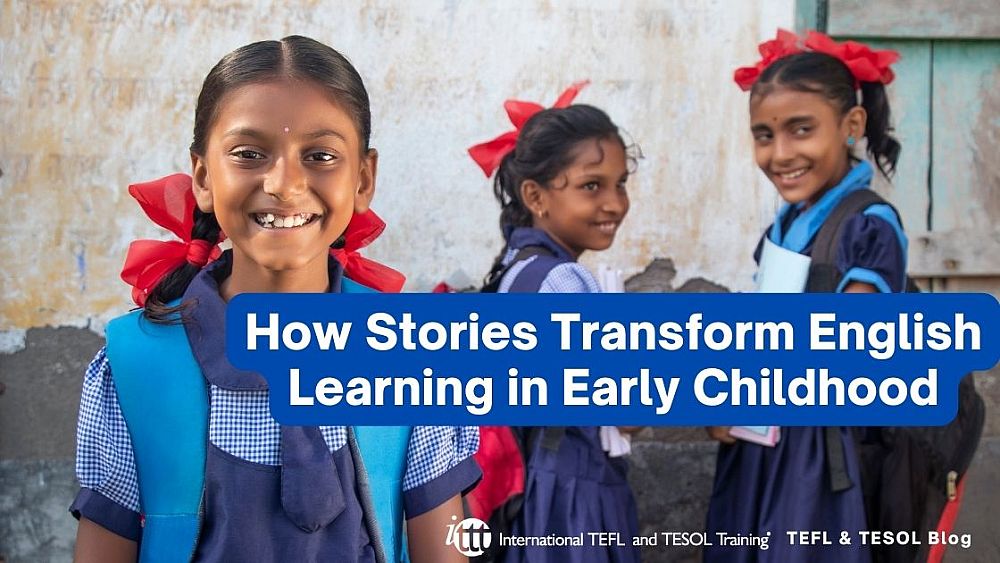How Stories Transform English Learning in Early Childhood

Stories are a powerful tool for engaging students in learning. Stories are capable of meeting young learners at their level by making language concepts engaging and interesting. They provide the sort of context and emotional stakes that are important for thorough language acquisition in a subtle way that doesn't always feel like sitting at a desk and learning through drills. This is why stories are an especially important tool when it comes to teaching young learners. Stories can provide motivation to learn, real-life examples of language usage, and an out-of-classroom opportunity to continue learning.
Table of Contents
Fostering Independent Learning
Are you ready to teach English as a foreign language?
Check out what our course grads say in our many video testimonials!
Disclaimer: The views and opinions expressed in this blog post are solely those of the author, an alumni of ITTT (International TEFL and TESOL Training). They do not necessarily reflect the views or opinions of ITTT. The content provided in this post is for informational purposes only and should not be considered as official endorsement or representation by ITTT.
Engaging Young Learners
Stories are, by nature, meant to be engaging, which can be very motivating for young learners who are typically difficult to keep engaged. They contain interesting characters, entertaining plots, and sequences of events that keep readers and listeners invested to hear more. A child learner is not typically interested in clear language goals such as professional development or prestige. Because of this lack of value, child learners can easily become demotivated when language learning becomes difficult. Through an engaging story, a child is more likely to be motivated to learn so they can follow what will come next. They might relate to a character or a situation or simply find a story to be silly. Either way, stories are able to capture the attention of young learners in a way language drills cannot.
Real-Life Language Usage
Stories have a special way of using volleys of dialogue, emotional exclamations, and energy that can be hard to create in a classroom without them. It can be difficult to engage young learners ages ten to thirteen in role-play language activities given that they are conscious of their peers and image at this time. In this way, stories are essential to providing students in this age range with real-life examples of language they may be too self-conscious to come up with on their own. By having students read dialogue from a story or even participate in a discussion on what is happening in a story, students are able to participate and use their target language in a way that keeps the focus off of themselves and on the plot. In this age group, stories are also helpful in their use of less-strict language. Stories can introduce young learners to comedic dialogue and exclamations they may want to repeat to impress their friends.
Fostering Independent Learning
By engaging students in stories within the classroom and providing them with resources to seek similar stories outside of the classroom, a teacher can provide a low-stakes, unpressured way for students to engage with what they learned in their free time. This can solidify information learned in the classroom while still feeling fun and like a leisure activity for young students. Examples of this could be comic books, children's cartoons, even funny YouTube videos. Stories give students an opportunity for immersion in cultural ideas and day-to-day language from the comfort and safety of their own home. By encouraging the consumption and production of stories, a teacher can influence a whole class of students to be lifelong learners of and participants in a language.
The Enduring Power of Stories
Stories serve as an incredible source of motivation for young learners, provide real-life examples of language usage, and can be used to motivate students to continue their learning outside of the classroom. Stories are, by nature, fun and engaging to people. They have existed across the world since the beginning of humanity and are heavily present in first-language acquisition. It is no surprise that stories are an incredibly useful and powerful resource when it comes to teaching a second language to young learners.
Are you ready to teach English as a foreign language?
Apply now & get certified to teach english abroad!
Speak with an ITTT advisor today to put together your personal plan for teaching English abroad!
Send us an email or call us toll-free at 1-800-490-0531 to speak with an ITTT advisor today.
Related Articles:
- Top 10 Cities in Europe with the Highest Demand for English Language Teachers
- 5 Reasons To Take A TEFL Course Right Now - Even If You Are Not Leaving Yet | ITTT | TEFL Blog
- All the Documents You Will Need to Teach English Abroad
- The Impact of Positive Motivation on an ESL Classroom
- You're Never Too Old to Change Your Life and Do a TEFL Course | ITTT | TEFL Blog
- Getting Student Placement Right - The Best Desk Arrangements for EFL Students



